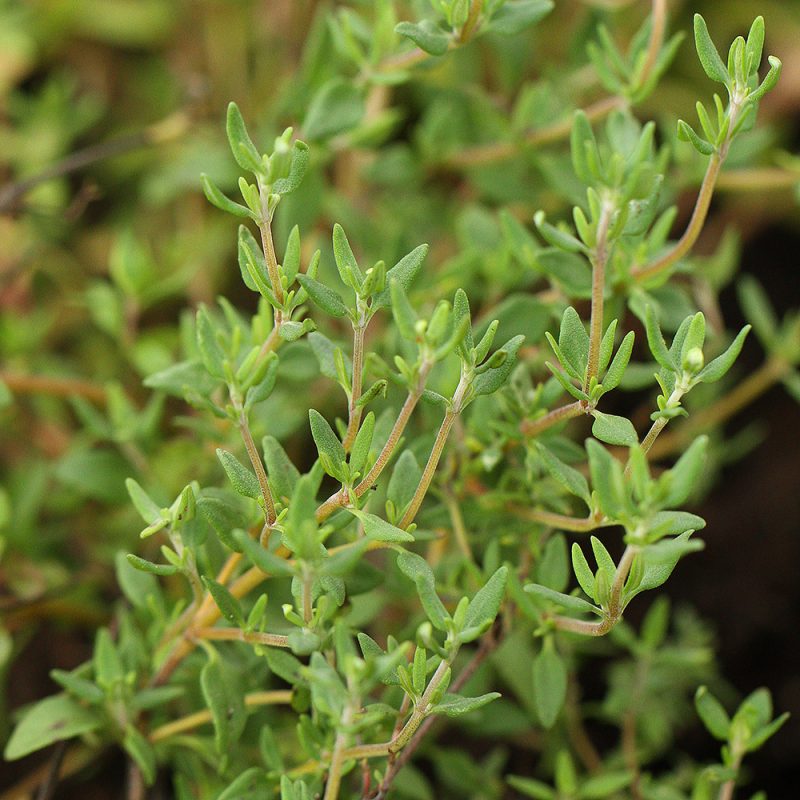
Thyme can withstand winter and come back in the spring, but in colder climates add pine boughs or a heavy layer of mulch over the thyme to protect it from the cold. Start over with each plant after four years of growth, as it will begin to become woodier during that time. Each spring, cut thyme plants back to half of its growth, as this encourages the plant to retain tender stems and a bushy appearance. Thyme doesn’t require much care other than general pruning. If growing thyme in containers, repot the thyme every season, as its roots may begin to grow out the bottom of the container. Flowers can be used aromatically or added to teas. Prune thyme flowers as they appear as this encourages more leaf growth. The soil should be a dark brown color and damp to the touch. Check out this post for more details: Growing Thyme From Cuttings. This is a straight-forward process, and can be done with or without the use of a rooting hormone. Immediately after, spray your soil 5-10 times. Probably the easiest way to grow thyme is to regrow it from some cuttings for another plant.
Growing thyme full#
Begin by filling a 3-inch peat pot 80 full with your potting mix. Thyme also requires soil with good drainage to prevent root rot, so plant it in a sandy, dry soil. Start your thyme seeds inside 8-10 weeks before you plan on moving them into your garden or a large pot. Since it prefers slightly alkaline soil, add lime to the soil to raise the pH. As your thyme grows, some rejuvenating pruning will be needed as the plant becomes woody with age. Quick and Easy DIY Container Herb Gardens In order to grow the most flavorful thyme, give it full sun. Thyme grows best in full sun in soil with a pH of 7.0. Because thyme prefers dry conditions, it makes a superb choice for a rock or container garden.

Once thyme reaches 3 inches in height, transplant it outdoors. If you would like to grow thyme from seeds, follow these steps for growing thyme seeds: Gently scatter seeds over the soil in the container you will be planting thyme seeds. If planting from seed, begin thyme indoors and scatter the seeds on top of the soil and do not cover them or only cover them lightly. Because of this, it is usually grown from divisions or cuttings. Either liberally use a mister spray or place the seed tray in water for 10 minutes, and it will soak up the water through the drainage holes at the bottom. Thyme grows very slowly from seed and after planting, germination can take up to 28 days. To grow thyme from seed, prepare a seed tray using free-draining potting mix, and dampen but don't over-wet the soil. Thyme will bloom tiny blossoms of pink, lavender or white throughout the spring and summer seasons which will attract bees to the garden. Thyme grows best in sandy loam soils ranging from pH 6.0 to 8.0. If youre planting from seed, sprinkle them a few inches apart and lightly cover with soil. Thyme does well when planted along walkways or in a container. Thyme should be planted about a foot apart. It is most often used to flavor meats and vegetables. If you are growing thyme in containers, plant with rosemary, which also likes sunny conditions and has similar watering needs.Thyme is a smaller herb that grows upright on a woody stem and has needle-like leaves.
/grow-thyme-indoors-1902495-02-6cfdad3b59e14b4187b348453f280a82.jpg)
Space thyme plants 12 to 24 inches apart in a very sunny area with fertile, well-drained soil with a pH.

Thyme thrives in full sun and loves heat. If you are growing in a pot indoors, plant near a sunny window. An excellent container for growing thyme is a clay planter.


 0 kommentar(er)
0 kommentar(er)
